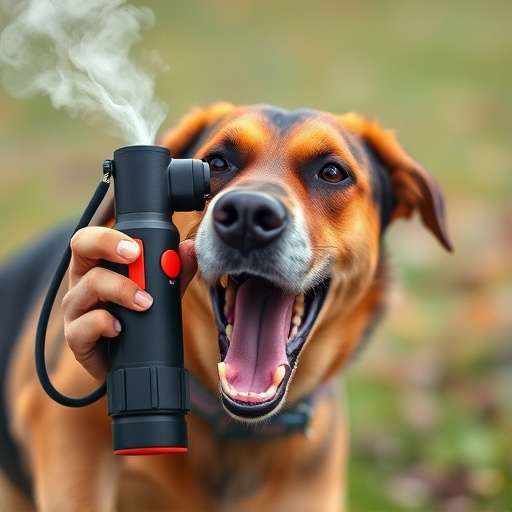Dog Repellent Spray Training Exercises offer a strategic, safe approach to teach canines appropriate behavior by temporarily disrupting focus with a powerful scent. Integrate spray usage with command words and positive reinforcement during short, regular practice sessions to reinforce learning. Begin in low-stress situations, gradually increasing intensity while consistently practicing for effective aggression modification.
Dog owners often face unexpected encounters, and being prepared for potential dog attacks is crucial. This is where Dog Repellent Spray comes in as a valuable training tool. Our article explores ‘Dog Attack Spray Quick Release’ techniques, offering insights into its safety, integration with behavioral training, and effective exercises for positive reinforcement. Learn how these practices can enhance your dog’s behavior and ensure everyone’s safety during walks. Discover the power of Dog Repellent Spray Training Exercises.
- Understanding Dog Attack Spray: A Safe Training Tool
- Integrating Dog Repellent Spray into Behavioral Training
- Effective Exercises for Positive Reinforcement with Dog Spray
Understanding Dog Attack Spray: A Safe Training Tool
Dog attack spray, also known as dog repellent spray, is a safe and effective tool for training exercises designed to teach canines appropriate behavior in response to potential threats. This innovative product emits a powerful scent that temporarily disrupts a dog’s focus, allowing handlers to redirect their attention during training sessions. By using controlled bursts of spray during specific commands or scenarios, trainers can reinforce positive behaviors while mitigating the risk associated with live demonstrations or intense role-playing exercises.
The key to successful integration of dog repellent spray into training routines lies in its strategic application. Handlers must select appropriate triggers and situations for spray release, ensuring that dogs associate the scent with specific actions or environments. Regular practice sessions, incorporating both spray and traditional reinforcement methods, help build a strong behavioral response. This balanced approach not only enhances overall canine training but also promotes a safer learning environment for both dogs and their handlers.
Integrating Dog Repellent Spray into Behavioral Training
Incorporating dog repellent spray into behavioral training can be a highly effective strategy to teach your canine companion appropriate boundaries and responses to unwanted stimuli. Dog repellent sprays, designed to deter dogs from approaching or engaging with certain areas or objects, can serve as a powerful tool during training sessions. By combining the spray with specific commands and positive reinforcement, you can help your dog understand what behaviors are acceptable and which ones will result in the unpleasant sensation of being sprayed. This method is particularly useful for addressing issues like jumping on furniture, barking at strangers, or pursuing other animals.
Training exercises involving the dog repellent spray should be conducted in a controlled environment, ensuring the safety and comfort of all involved. Start by introducing the spray in a low-stress situation, allowing your dog to become familiar with its scent without triggering an adverse reaction. Gradually increase the intensity of the training by pairing the spray with commands like “No” or “Stop.” Reward your dog with treats and praise when they exhibit the desired behavior upon hearing the command. Consistency is key; regular practice sessions will reinforce the learning process, making it more likely that your dog will generalize their understanding to various situations and environments.
Effective Exercises for Positive Reinforcement with Dog Spray
Training your dog using a dog repellent spray can be an effective way to teach them to avoid aggressive behaviors, but it’s crucial to employ positive reinforcement techniques for best results. Start by selecting a specific command, like “leave it” or “stop,” that you’ll use consistently during sessions. Prioritize short training bursts, lasting around 10-15 minutes, several times a day to maintain your dog’s focus and enthusiasm.
Use the dog repellent spray when your pup is in a calm state, such as after they’ve taken a break or during a moment of stillness. Present the spray in a controlled manner, perhaps by holding it near their nose and saying your chosen command. Reward them with treats and praise as soon as they exhibit the desired behavior, like turning away or pausing their advance. This immediate positive reinforcement will help reinforce the association between the spray, the command, and the desired outcome.
Dog repellent spray, when used responsibly and as a part of positive reinforcement training exercises, can be an effective tool in managing and preventing aggressive behavior in dogs. By integrating this safe training aid into behavioral modification programs, owners can help their pets become more confident and well-behaved in various situations. Consistent practice and positive reinforcement are key to success with dog repellent spray training exercises, ultimately fostering a stronger bond between owner and pet.
